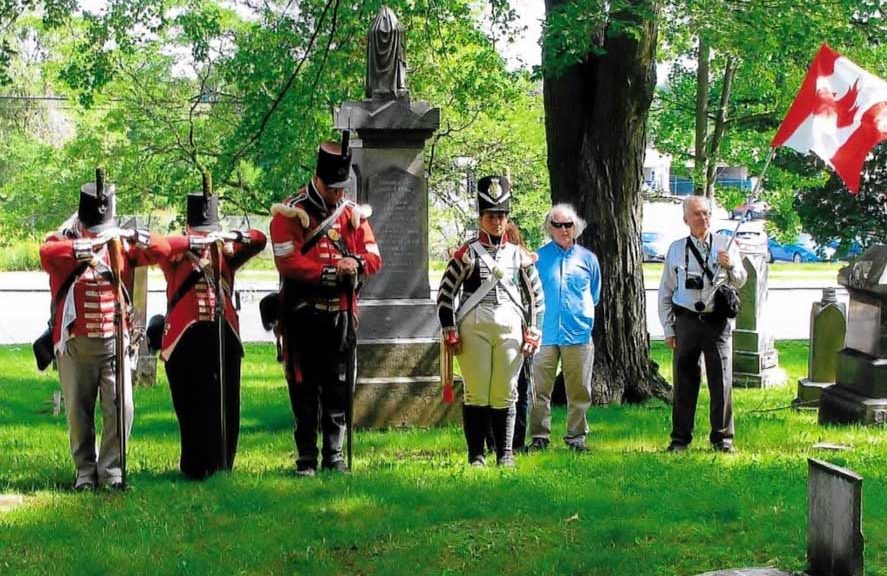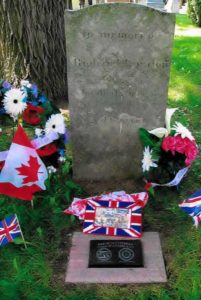
Richard London SUE was born in 1772 in Greenwich, Sussex, New Jersey, USA. He was the son of Bartholomew London UEL, (Source: Upper Canada Land Petitions ‘L’ Bundle 20, 1837, RG 1 L3, V.295, Petition 54, C-2131, Archives Canada) a farmer, whom had suffered from being loyal to the British forces during the war.
“… he has been almost three months in one prison and from there removed to another when he was detained some time on suspicion of recruiting men for His Majesty’s Forces. He has suffered the loss of both health and property for his loyalty …”
(Source: Upper Canada Land Petitions ‘L’ Bundle 1, 1792-1795, RG 1 L3, V.283, Petition 20, C-2124, Archives Canada).

After getting out of prison Bartholomew London UEL
“…came into the province in the year 1789 with a daughter and three sons and four grand children…”
(Source: Upper Canada Land Petitions ‘L’ Bundle 1, 1792-1795, RG 1 L3, V.283, Petition 20a, C-2124, Archives Canada) and settled in Saltfleet Township. Bartholomew London and his son, Richard, petitioned together for land, and Bartholomew received Lot 18 & 19 Conc. 3, Saltfleet and Richard London received Lot 16 &17 Conc. 3, Saltfleet (Source: Upper Canada Land Petitions, L Bundle 1, 1793, RG 1 L3, V.283, Petition 5, C-2124, Archives Canada, and First Map of Saltfleet, 1791). Richard’s brother-in-law, Enoch Moore, received Lot 20, Conc. 3, Saltfleet and Lots 14, 15, 16, 17 Conc. 4, Saltfleet, and Richard’s brother (Jeremiah), who came after 1790, (he is found in the New York census of 1790, did not petition with his father and brother, and was found on the 1808 survey of Saltfleet) was granted Lots 27 & 28, Conc. 5, Saltfleet.
Children of Bartholomew London UEL and 1st wife:
- Jeremiah b1754 m Margaret Prall (children: Aaron, Joseph, Margaret) *Aaron and Joseph London fought in the War of 1812
- Charles
- Thomas
- Jane b1760 m1 Enoch Moore (children: Charles, Thomas, Sarah, Mary) m2 John McDavid (McDeade)
- Mehitable “Hettie” b1765 m1 William Disher (child: Bartholomew) m2 Andrew Whitsell
- Richard b 1774 d 1839 m Maria(h)
Bartholomew London UEL and 2nd wife Mary Osborn(e)’s children:
- Hannah b 1800 m John Cowell
- Catharine b 1801 m John Rittenburg
Sons of Mary Osborn(e) :
- Nathaniel Osborn(e)
- William Osborn(e)
Will of Bartholomew London names his children. (Source: Lincoln County Surrogate Court Records, estate proved and settled to Jeremiah and Richard London, 5 March 1801; FHL film #0579149). Bartholomew London’s daughter, Hannah Cowell, petitioned for her father’s land after his death.
“That lots numbered 18 & 19 each containing one hundred acres in the third concession of Saltfleet aforesaid were located by her late father Bartholomew London – deceased – who devised the same lands by will to Petitioner …”
(Source: Upper Canada Land Petitions “C” Bundle 12 1816-1820, RG 1, L3, V. 103, Petition #298, Archives Canada).
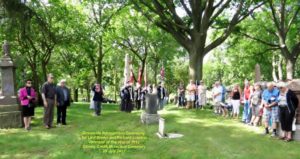
Bartholomew was murdered by his second wife (Mary Osborne) and George Nemires on February 17, 1801. She was the first to be executed for murder and first woman to be hung in Upper Canada. The trial in front of Judge Henry Alcock and his associates Robert Hamilton and William Dickson was held on the 14th of August 1801 in Niagara-On-The-Lake, Ontario. The prosecutor was Attorney General Thomas Scott. Silvester Tiffany, the printer and editor of the Niagara Herald, covered the trial and execution in detail, in a time period in which local and provincial news was brief. Catharine, her daughter (only a few days old) was baptised by Robert Addison the day before the execution. (Source: Articles in Niagara Herald written by Silvester Tiffany February 1801-August 1801).
Private Richard London and his wife Maria(h) (b 1780 d 1840) had the following children:
- Jeremiah b 1800 d 1883 m. Phoebe Cutler
- Magdalene b 1804 d 1861 m. James Adair
- Susanna b 1806 m. Joseph Adair
- Elizabeth m. Leo Davis
- John m. Nancy Ayers
- Daniel m. Mary Ann Foster
- Anna b 1817 d 1893 m Isaac Corman Jr (son of Private Isaac Corman 2nd Flank 5th Regiment Lincoln Militia)
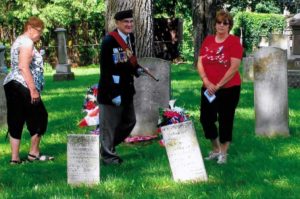
Richard was a private in the 5th Regiment Lincoln Militia during the War of 1812-1814. He fought in Captain John Smith’s Company 5th Regiment Lincoln Militia and Captain Gesham Carpenter’s Company 5th Regiment Lincoln Militia in 1813. In 1814 he fought in Lieutenant Colonel Andrew Bradt’s Company 5th Regiment Lincoln Militia and Captain Robert Land’s Company 5th Regiment Lincoln Militia (Source: Militia and Defence RG9 1B7, V.24, pages 171, 237, 266, 283, 308, 409, 502, and 551, National Archives of Canada). He fought along-side his son-in-law, Isaac Corman Jr.’s, father (Private Isaac Corman) during the late war.
“… the said Richard London was also faithful during the late war…”
(Source: Upper Canada Land Petitions “L” Bundle 20, 1836-1837, RG 1 L3, V. 295, Petition 54a, C-2131, Archives Canada).
Richard London died 3 Jun 1839 in Stoney Creek, Wentworth County, Ontario, Canada at age 67 years. He is buried in the Stoney Creek Municipal Cemetery.
Included by Applicant for an understanding of the times and environment — Graveside Team
Osborn, Mary (London)
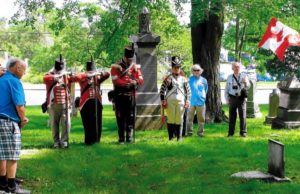
OSBORN, MARY (London), convicted murderer; b c1773 in Bedford, Pa; m Bartholomew London, and they may have had one child; d 17 Aug 1801 in Niagara (Niagara-on-the-Lake), Upper Canada.
In the early years of Upper Canadian settlement major crimes were infrequent and cases resulting in capital convictions rare. Attorney General John White* complained in 1795 to the French traveller
La Rochefoucauld-Liancourt* that, although one or two people had been tried for murder in every district of the province, “they were all acquitted by the jury, though the evidence was strongly against them.” Convictions were indeed difficult to obtain. But the sparing ways of the juries aside, between August 1792 and September 1800 there were six cases ending in capital convictions: four for burglary, one for forgery, and one for murder. Three of these trials were of black slaves, among them Jack York*; the first execution in the province’s history was of the black slave Josiah Cuttan (Cutten) in 1792. The first execution for murder and the first execution of a woman occurred in 1801.
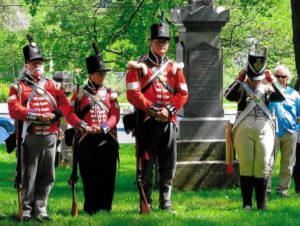
In the late summer of that year the attention of the Niagara peninsula was riveted on the trial of Mary London and George Nemiers (Nemire) for the murder of her husband. The trial was sensational in appeal, exposing the adultery of young lovers, the betrayal of an old husband, the role of unnamed accomplices and confidants, and clandestine trips to obtain poison. Moreover, the local appetite for scandal was whetted by the first newspaper coverage of a criminal trial held in the province. For reasons that are not entirely clear, the printer and editor of the Niagara Herald, Silvester Tiffany, covered the trial and execution in detail extraordinary for a period in which local and provincial news rarely received more than short shrift. For the most part, the following account is based on his reports.
The basic outline of events leading to the trial seems clear. In 1789 Bartholomew London, a small farmer from New Jersey who claimed to have been imprisoned during the American revolution because of his loyalty to the British, entered the province with four children and four grandchildren.
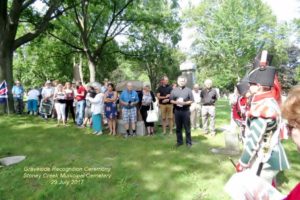
Drawing on the support of a fellow New Jerseyman and local office holder, Nathaniel Pettit, he obtained a grant of 200 acres in Saltfleet Township. An older man, he appears to have been unmarried upon his arrival in the colony. At some point he married the young Mary Osborn, an emigrant from Pennsylvania whose family still resided there in 1801. How they met is unknown, but whatever the scenario it was complicated by the appearance of George Nemiers. About 28 years of age and from Carlisle, Pa, Nemiers likely worked as a labourer on the London farm. By December 1800 Mary London and Nemiers were lovers. When Bartholome London died on 17 Feb 1801, Mary, then four months pregnant, and Nemiers were arrested and charged with felony and murder.
The trial began on the morning of 14 August before judge Henry Allcock and his local associate justices, Robert HAMILTON and William Dickson*. The petit jury included the Niagara merchants James Crooks* and John DUN. Among the 14 witnesses were Tiffany, his brother Oliver, Dr Robert Kerr*, and Robert Nelles*. Attorney General Thomas Scott* opened the proceedings with an address to the jury which, according to Tiffany…
“moistened many eyes, and captivated many hearts.”

Eight hours were then spent in examining the witnesses. The coroner and medical men established that London’s death was a result of poisoning and not a fractured skull. The rest of the testimony was apparently circumstantial, but Tiffany, himself a witness, reported that, although there was a lack of “positive proof as to the person or persons who administered the poison,” “the facts and the numerous circumstances left no room for doubt.” After the jury delivered its verdict of guilty, Allcock, “who had all along ‘judged with mercy,’” pronounced the “dreadful sentence.” On the morning of 17 August, the lovers were to be hanged “until they be dead, dead, and afterwards their bodies to be Dissected.”
The interlude of two days gave Tiffany time to interview the two convicts. Nemiers, “penitent and perfectly resigned,” absolved his “honest parents… who discharged their duty in instructing him in the strict observance of the Sabbath and his duty to God and man… and blamed none but the guilty copartner in the crime… who lured him to unlawful intimacy and connection about nine months ago, and from the sin of adultery to that of murder.” She had first suggested “shooting the old man” and later raised the possibility of poison. Nemiers attempted to obtain poison at Ancaster, but “he there felt some remorse of conscience.” Later, his moral qualms resolved, he secured two ounces of arsenic and one ounce of opium from a “medical gentleman” in Canadaigua, N.Y. (Tiffany’s home after leaving the province in 1803). Insisting that “it was not the estate, but the woman he wanted,” and that a third party was involved in the crime, he confessed to causing London’s skull fracture with a shoe-hammer.
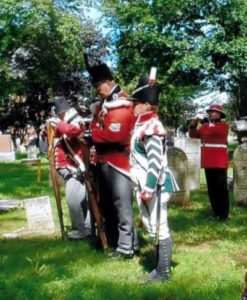
But it was Mary London’s seeming indifference “to a sense of her true standing” that intrigued Tiffany. Possibly because she was a female, Tiffany had expected a full confession. Instead all she had offered during the trial was “a partial confession… framed to her own innocency and the guilt of Nemiers.” When Nemiers spoke to Tiffany of a guilty third party, she “checked” him, saying “two of us to die for this is enough.” But afterwards she confirmed that another had suggested murdering London to get “the old rascal out of the way.” She denied administering anything more than opium to her husband, indicating that the unnamed accomplice was the culprit. But the contradictions in her story and her tendency to lie led Tiffany to disregard her statements and conceal the names of those implicated. Only once did her steely reserve falter: returning to her cell after sentencing she had cried aloud, “I am guilty, I gave the poison and knew it.” To Tiffany, she later confided that she did not know who was the father of her child, Catherine, then but a few days old and baptized by Robert Addison* the day before the execution. Like Nemiers, she did not blame her parents “for any neglect.” Tiffany believed that Mary first realized her fate in the preparation room on the morning of the 17th:
“When she came out to her place, she said, ‘May this be a warning to you all,’ and prayed to God to have mercy on her soul.”
The execution was attended by a “large concourse of people” and was marred when “a female (it is to be regretted it was one of that sex)” mocked the cries and gestures of Mary London. Following English practice, the bodies were turned over to medical men for dissection, the first instance in Upper Canada of a procedure that continued at least until the execution of William Kain* in 1830. As was often the case with criminal trials during this period, the convicted passed quickly from the written record and possibly from memory. Tiffany saw in the case a moral lesson: “Visible in the whole of this business, [is] the hand of Providence pursuing with vengeance offenders even in this life; for in it we see punished adultery, disregard of marriage vows, and murder: and to those who indulge themselves in the two former, it may be a lesson of instruction, that from them to the last is but a step.”
Robert Lochiel Fraser III

AO, RG 1, A-II-1, 1: 143–44; C-IV, Saltfleet Township, Lots 18–19, Conc 3; RG 22, ser. 134, 3: 22, 45, 80, 88, 94, 102, 131. Hamilton Public Library (Hamilton, Ont.), Buchanan papers, ledger of an early doctor of Barton and Ancaster, 1098. PAC, RG 1, L3, 283: L1/5, 20, 68. Wentworth Land Registry Office (Hamilton), Abstract index to deeds, Saltfleet Township: ff.124–27 (mfm. at AO, GS 1627). York North Land Registry Office (Newmarket, Ont.), Abstract index to deeds, King Township: 149 (mfm. at AO, GS 5840). Early records of Niagara (Carnochan), OH, 3: 18. [F.-A.-F. de La Rochefoucauld-Liancourt], La Rochefoucault-Liancourt’s travels in Canada, 1795, [translated by Henry Neuman] with annotations and strictures by Sir David William Smith…, ed. W. R. Riddell, AO Report, 1916: 40. Niagara Herald (Niagara [Niagara-on-the-Lake, Ont.]), 15, 22 Aug. 1801. W. R. Riddell, The first legal execution for crime in Upper Canada, OH, 27 (1931): 514–16.
Submitted by 3rd great grand daughter Brenda Denyes UE and Paul Preece UE
Veteran Summary
Richard LondonPrivate, 5th Regiment Lincoln Militia
Place of Birth
Greenwich, Sussex, New Jersey, USA
Place of Death
Stoney Creek, Wentworth County, Ontario, CAN
Died on: 03 JUN 1839
Reason: Richard died at age 67 years old
Location of Grave
Stoney Creek Municipal Cemetery, King Street
Hamilton, ON, CAN
Latitude: 43.219023N Longitude: -79.770009

